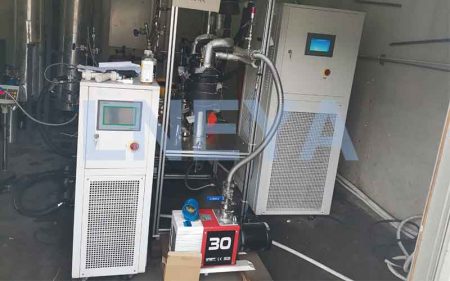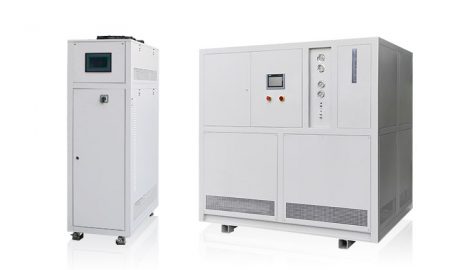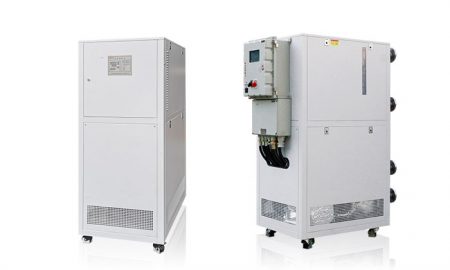Emulsifier Heating Process
Kontaktieren Sie uns noch heute für die perfekte Lösung zur Temperaturkontrolle
In fluid mixing industrial production, most powder-liquid, solid-liquid, and liquid-liquid mixing require multiple processes of mechanical equipment to meet the required standards of the product. These processing steps often include: heating, dissolving, dispersing, stirring, homogenizing, emulsifying, sterilization, cooling, etc. Except for some cold-processed products, most products require a heating process during the mixing process. The heating process often requires the product to be fine, uniform, well dispersed, stable, etc. The heated materials of thermal processing products can be better sheared, homogenized and emulsified, allowing the product quality to reach a better state.

What are the heating methods of emulsifier?
1. Electric heating method
Among the emulsifier heating methods, electric heating is a common heating method. The electric heating method usually uses an electric heating rod installed in the emulsification tank to heat the medium in the interlayer of the emulsification tank: water or thermal oil. After the medium is heated, it transfers heat to the materials in the emulsification tank. The electric heating emulsifier has a fast heat transfer speed and uses a thermocouple to measure the temperature and connect it to a temperature controller to measure and control the temperature. The temperature control is adjustable and convenient; the temperature measurement is accurate. This heating method is convenient, hygienic, economical, safe and has a long heat preservation time.
2. Steam heating method
In some large-scale emulsifier equipment, or in situations where the process has temperature or other requirements, steam heating is often used to heat the materials. This heating method usually requires the customer to have a steam source, such as an industrial boiler. If there is no steam source, additional steam generator equipment is required to generate steam in advance through electrical heating for reuse. This heating method has fast heating speed, easy use and cooling, and can also be used for steam sterilization process. However, since this heating method creates pressure on the emulsification pot of the high-shear vacuum homogenizing emulsifier, it is often necessary to heat the pot with steam into the pressure vessel through an enterprise with a pressure vessel license to ensure production safety. Therefore, this heating method is relatively expensive.
In the production process of some products, standard electric heating and steam heating cannot meet the temperature requirements. External heating equipment can also be optional, such as external mold temperature controllers, chillers and other auxiliary equipment. To sum up, generally speaking, electric heating emulsifiers are more economical and affordable, and the heating effect and other aspects are guaranteed. From the perspective of cost, electric heating is more practical and therefore has a wider range of uses. Steam heating emulsifier is suitable for situations with large-scale output or special process requirements. In the production of products in some industries, especially the pharmaceutical industry that requires steam sterilization, steam heating is also commonly used.
E-Mail: info@lneya.com WeChat ID: +8615251628237 WhatsApp: +86 17851209193

Kühl- und Heizsysteme (Serie SUNDI)
Temperaturregelbereich: -120°C bis +350°C
Anwendung: Verschiedene Reaktoren (Mikrokanäle, Glas, ummantelte Reaktoren usw.), Destillations- oder Extraktionssysteme, Labor, Universität, Forschungsinstitut, Luft- und Raumfahrt, Automobilindustrie, Halbleiter- und Elektrotests, Chemie, Pharmazie, Petrochemie, Biochemie, Medizin, Krankenhaus, F&E-Werkstatt, Luft- und Raumfahrt, Biologie und andere Industrien.
| Temperaturbereich | Serie -10 ~ +150°C | Serie -25 ~ +200°C | Serie -25 ~ +300°C | Serie -45 ~ +250°C | Serie -45 ~ +300°C | Serie -60 ~ +250°C | Serie -60 ~ +300°C | Serie -70 ~ +250°C | Serie -80 ~ +250°C | Serie -90 ~ +250°C | Serie -100 ~ +100°C | ||
| Kühlleistung | 1,5 ~ 15kW | 1 ~ 200kW | 1 ~ 200kW | 0,45 ~ 200kW | 0,9 ~ 25kW | 0,25 ~ 60kW | 0,75 ~ 25kW | 0,4 ~ 15kW | 0,3 ~ 80kW | 0,2 ~ 80kW | 0,45 ~ 80kW | ||
| Hinweis: Jeder Temperaturbereich von -150℃ ~ +350℃ und jede Kühlleistung kann angepasst werden | |||||||||||||

Kühl- und Heizsysteme (WTD-Serie)
(Mikrokanal / Röhrenreaktoren spezialisiert)
Temperaturregelbereich: -70°C bis +300°C
Spezielles Design für Mikrokanäle (geringe Flüssigkeitsspeicherkapazität, starke Wärmeaustauschkapazität, Zirkulationssystem mit hohem Druckabfall)
| Temperaturbereich | -70°C ~ +300°C | -45°C ~ +250°C | -70°C ~ +200°C | ||||||
| Kühlleistung | 1.1 ~ 7.5kW | 1.5 ~ 5.5kW | 11 ~ 50kW | ||||||
| Hinweis: Jeder Temperaturbereich von -150℃ ~ +350℃ und jede Kühlleistung kann angepasst werden | |||||||||

Umwälzpumpen für Kühlung und Heizung
Temperaturregelbereich: -45°C bis +250°C
Anwendung: Verschiedene Reaktoren (Mikrokanäle, Glas, ummantelte Reaktoren usw.), Destillations- oder Extraktionssysteme, Labor, Universität, Forschungsinstitut, Luft- und Raumfahrt, Chemie, Pharmazie, Petrochemie, Biochemie, Medizin, Krankenhaus, F&E-Werkstatt, Luft- und Raumfahrt, Biologie und andere Industrien.
| Temperaturbereich | Serie -25°C ~ +200°C | Serie -45°C ~ +250°C | |||||||
| Kühlleistung | 1 ~ 15kW | 0,25 ~ 15kW | |||||||
| Hinweis: Jeder Temperaturbereich von -150℃ ~ +350℃ und jede Kühlleistung kann angepasst werden | |||||||||

Heizungsumwälzpumpen
Temperaturregelbereich: +50°C bis +300°C
Hinweis: Die UC-Serie kann die Temperatur des Wärmeträgermediums regeln. Die UST-Serie kann nicht nur die Temperatur des Wärmeträgermediums, sondern auch die Temperatur des Reaktionsmaterials regeln.
| Temperaturbereich | +50°C ~ +170°C (UC-Serie) | +50°C ~ +300°C (UC-Serie) | +50°C ~ +300°C (UST-Serie) | ||||||
| Heizleistung | 5,5 ~ 15kW | 3,5 ~ 130kW | 3,5 ~ 95kW | ||||||
| Hinweis: Jeder Temperaturbereich von -150℃ ~ +350℃ und jede Kühlleistung kann angepasst werden | |||||||||
 LNEYA
LNEYA
 简体中文
简体中文


















































































